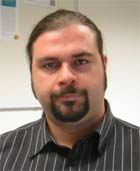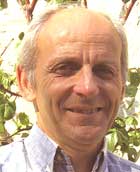Contents: 2024 | 2023 | 2022 | 2021 | 2020 | 2019 | 2018 | 2017 | 2016 | 2015 | 2014 | 2013 | 2012 | 2011 | 2010 | 2009 | 2008 | 2007 | 2006 | 2005 | 2004 | 2003 | 2002 | 2001
2007, 3
Acquire real-time RF digital ultrasound data from a commercial scanner
language: English
received 06.12.2006, published 24.01.2007
Download article (PDF, 450 kb, ZIP), use browser command "Save Target As..."
To read this document you need Adobe Acrobat © Reader software, which is simple to use and available at no cost. Use version 4.0 or higher. You can download software from Adobe site (http://www.adobe.com/).
ABSTRACT
Although new ultrasound signal processing can be designed from simulation data or recorded data, the development and prototyping of new medical ultrasound imaging tools is essentially based on processing the radio frequency (RF) data, which is the signal generated by the ultrasound probe. Unfortunately, the diversity and technological level of knowledge required for implementing a whole ultrasound scanner from scratches are usually found in the companies that manufacture such engines. The implementation of the new methods in the laboratories is then tributary to the interest and good will of those companies, and the lack of such experience makes technological transfers even more difficult. But another approach of the problem can be chosen: the direct acquisition of the real time RF data in a commercial scanner. This approach takes advantage of the high technological level of the transceiver of the commercial ultrasound scanners and frees the researcher from the post processing applied by each company. The side effects of such approach are resumed to the difficulty of interfering with the scanner’s electronic systems, but this problem is simplified by the high technological level of the modern engines. Indeed, their digital conception makes the electronic signals easier to understand and the manual operations safer, and the impact of an unfortunate manipulation is essentially reduced to a distortion of the scanner’s display. In this paper, the general approach of RF derivation in a commercial digital scanner is exposed. Then it is demonstrated on a commercial scanner, the Kretztechnic 530D, equipped with a volumic probe. This system allowed us to implement one of our current subjects of research, that is the Parallel Integral Projection for the localization of a micro needle in soft tissues, and to conclude on its performances on real data, including a minimum gain of 5.
Keywords: digital ultrasound scanner, radio frequency, real time radio frequency signal, auto synchronized bypass board
16 pages, 11 figures
Сitation: Jean Martial Mari, Christian Cachard. Acquire real-time RF digital ultrasound data from a commercial scanner. Electronic Journal “Technical Acoustics”, http://www.ejta.org, 2007, 3.
REFERENCES
1. Dydenko, N. Rognin, F. Jamal, C. Cachard, D. Friboulet. Contrast Agent Detection Based on Autoregressive Spectral Estimation. WCU Paris, pp. 193-196, 2003.
2. J. A. Jensen. A Model for the Propagation and Scattering of Ultrasound in Tissue. J Acoust Soc Am, vol. 89, N° 1, pp. 182-191, 1991.
3. J. Ophir, I. Céspedes, H. Ponnekanti, Y. Yazdi, X. Li. Elastography: A Quantitative Method for Imaging the Elasticity of Biological Tissues. Ultrason Imaging 13, pp. 111-134, 1991.
4. E. Brusseau, J. Fromageau, N. Rognin, P. Delachartre, D. Vray. Local Estimation of RF Ultrasound Signal Compression for Axial Strain Imaging: Theoretical Development and Experimental Results. IEEE Eng Med Biol Mag, pp. 86-94, 2002.
5. J. Bercoff, M. Tanter, S. Chaffai, M. Fink. Ultrafast Imaging of Shear Waves Induced by Acoustic Radiation-Force in Soft Tissues. 1st International Conference on the Ultrasonic Measurement and Imaging of Tissue Elasticity, Niagara Falls, Canada, 2002.
6. M. Arditi, T. Bernier, M. Schneider. Preliminary study in differential contrast echography, Ultrasound in Medicine and Biology. Ultrasound Med Biol, 23(8), 1185-1194, 1997.
7. W. G. Wilkening, J. H. Lazenby, H. Ermert. A method for detecting echoes from miccrobubble contrast agents based on time-variance. Biomedical Application, 1998.
8. J. M. Mari. Ultrasonic localization of strongly scattering inclusions in soft tissues, application to electrode detection. PhD thesis, 152 pages, Claude Bernard University Lyon 1, France, December 2004.
9. M. Barva, J. M. Mari, J. Kybic, C. Cachard. A Radial Radon Transform dedicated to Micro-object Localization from Radio Frequency Ultrasound Signal. IEEE Ultrasonic Symposium, Montreal, Canada, 2004.
10. M. Barva, J. M. Mari, J. Kybic, C. Cachard. Automatic localization of curvilinear object in 3D ultrasound images. Biomedical Engineering, Czech Technical University, Czech Republic, SPIE, 2005.
11. M. Berson, L. Vaillant, F. Patat, L. Pourcelot. High-resolution real-time ultrasonic scanner. Ultrasound Med Biol, vol 18, N° 5, pp 471-478, 1992.
12. S. Foster, M. Zhang, Y. Zhou, G. Liu, J. Mehi, E. Cherin, K. Harasiewicz, B. Starkoski, L. Zan, D. Knapik, L. Adamson. A new ultrasound instrument for in vivo microimaging. Ultrasound Med Biol, vol. 28, pp. 1165-1172, 2002.
13. L. Masotti, E. Biagi, M. Calzolai, L. Capineri, S. Granchi, M. Scabia. FEMMINA: a Fast Echographic Multiparametric Multi Imaging Novel Apparatus. IEEE Ultrasonics Symposium, pp. 739-748, 1999.
14. E. Biagi, M. Calzolai, M. Forzieri, S. Granchi, L. Masotti, M. Salerno, M. Scabia, M. Scortecci. Real Time Processing of the Radiofrequency Ultrasonic Echo Signal for on Line Spectral Maps. Proc. of the 24th International Symposium Acoustical Imaging, vol. 24, New York: Kluwer Academic / Plenum Press, 1998, pp. 95-100. 1998.
15. J. A. Jensen, O. Holm, L. Joost, H. Bendsen, S. Ivanov et al. Ultrasound Research Scanner for Real-time Synthetic Aperture Image Acquisition. IEEE Trans Med Imaging, vol. 22, N°1, 2003.
16. K. Thomenius. Evolution of ultrasound beamformers. IEEE Ultrasonic Symposium, pp. 1615-1622, 1996.
17. N. Rognin, C. Mérel, C. Cachard, E. Brusseau, G. Finet. Ultrasound Contrast Agent in Intravascular Echography: Parametric Mapping Based on RF Output. IEEE Ultrasonic Symposium, pp. 1787-1790, 2000.
 |
Jean Martial Mari was born in 1976 in Saint Denis of the Reunion Island (France). He received the Electrical Engineering Diploma of the INSA Lyon, France, in 2000 with a specialisation in Signal Processing, and a PhD in Acoustics at the Université Lyon 1, France, in 2004. He joined the Medical Vision Laboratory, University of Oxford, in 2005 on Ultrasound Contrast Agent and imaging artefacts correction. His general research interests include ultrasonic observation of surgical micro instruments, linear and non linear imaging and technical acoustics. e-mail: mari(at)robots.ox.ac.uk |
|
 |
Christian Cachard was born in Saint Etienne (France) in 1956. He received a Diploma of Electronic Engineering in 1979 from the ENSAI Strasbourg, a Masters in Acoustics from the LMA Marseille in 1980 and a Ph. D. in Acoustics from the INSA Lyon in 1988. He was successively Assistant Professor and Professor at the Electrical Engineering department of the Technical Institute of the Université Lyon 1. Until 1990 he was working on the interaction of acoustic waves with bubbles in underwater applications. In 1992, when the Center for Research and Applications in Image and Signal Processing (CREATIS) oriented its research towards medical applications, Christian Cachard joined the ultrasound group and worked on IVUS artefacts and ultrasound contrast agents. He is interested in processing ultrasound radio frequency signals in 3D for micro tools detection. e-mail: christian.cachard(at)creatis.univ-lyon1.fr |
|
